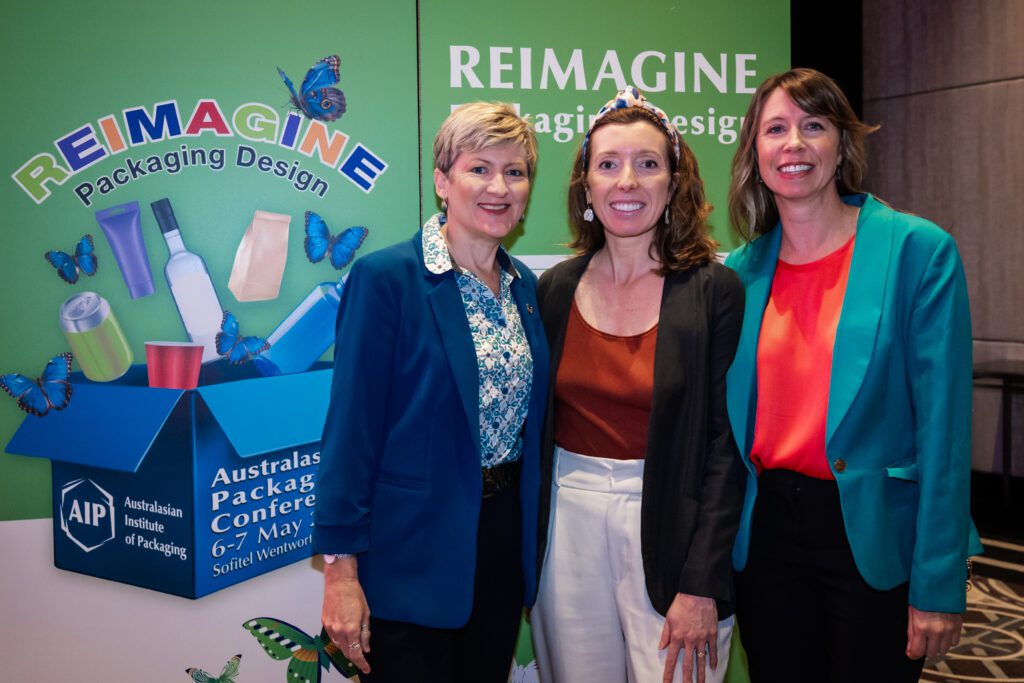Reimagining Packaging Design: Key Takeaways from the AIP 2025 Conference
A Sustainability Journey, Business Services, Design, Printing & Packaging, Education, Social & Environmental Services, Technology
A Sustainability Journey, Business Services, Design, Printing & Packaging, Education, Social & Environmental Services, Technology
This article was contributed by Philo & Co.
At this year’s AIP Packaging Conference, the message was clear: the packaging sector is on the cusp of major transformation. With regulatory reform accelerating and design under sharper scrutiny, the industry gathered with urgency and optimism to explore how packaging can deliver lasting, system-wide change.
I had the privilege of opening and closing the event alongside Nicole Garofano (Planet Ark) and Bel Chellingworth (BC Consulting), guiding conversations on circular systems, lifecycle thinking, and human-centred design. The future of packaging is no longer just about recyclability — it’s about redefining packaging’s role across the economy, environment, and everyday life.

Photographed by Oneill Photographics.
Australian Packaging Covenant Organisation (APCO) CEO Chris Foley made it clear: a harmonised national Extended Producer Responsibility (EPR) framework is on its way — and it’s coming fast. With renewed political certainty post-election, packaging reform will accelerate, guided by APCO’s 2030 Strategy that introduces eco-modulated fees to incentivise better packaging design.
“If you’ve been hoping for a reset or a slowdown, I wouldn’t be expecting it,” Foley warned. This signals a fundamental shift in accountability — where producers are responsible not just for packaging placed on market, but for its lifecycle outcomes too.
Brands and agencies must prepare now, translating regulation into actionable packaging strategies.

Photographed by Oneill Photographics.
While global goals guide ambition, success is local. In the Pacific region, PET recovery sits at just 2%, and soft plastics at 0.2%. As ANZPAC highlighted, circular strategies must reflect local infrastructure and social systems.
That means investing in scalable, context-specific EPR and take-back schemes — ones that meet communities where they are and support genuine material recovery.
Reuse continues to gain global momentum, but in Australia and New Zealand, it must consider our geography, behaviours, and infrastructure. With EPR placing pressure on volumes, reuse becomes a strategic imperative — not just a sustainability lever.
Suntory’s research showed the risks of poorly planned reuse — such as rebound impacts and trade-offs. In contrast, Woolworths’ reusable B2B crates, made from 90% recycled content and embedded with RFID tracking, proved how system-first thinking can deliver environmental and commercial wins.
Designing for reuse from the start enables waste reduction, cost savings, and long-term brand resilience.

Photographed by Oneill Photographics.
Less than 4% of personal care packaging is accessible, despite 16% of people globally living with a disability. That’s not just an equity issue — it’s a missed opportunity.
Inclusive packaging ensures products are usable for all people, regardless of ability, age, or circumstance. It enhances experience, expands reach, and builds social value into packaging design — a key consideration as regulations and consumer expectations evolve.
Smart packaging design depends on strong data. Lifecycle assessments (LCAs) and transparent packaging data help brands manage risk, prove claims, and align with eco-modulation incentives.
Without it, brands risk making decisions that increase impact or mislead consumers. With it, they can optimise outcomes, meet ESG goals, and ensure compliance with guidelines such as the ACCC’s crackdown on greenwashing.

Photographed by Oneill Photographics.
AI is reshaping how FMCG brands and design agencies model structure, usability, and performance — long before a prototype is made. By simulating early, teams can cut costs, minimise impact, and make smarter packaging choices that align with EPR and LCA priorities.
Pippa Corry is the Founder & Director of philo & co, a circular economy and sustainable packaging consultancy, helping FMCG brands and design agencies create sustainable, compliant, and future-fit packaging solutions. Our expertise spans the entire packaging supply chain—from materials to recovery systems and evolving regulations—guiding businesses through the complexities of sustainable packaging design, strategy, and communication.
This is an article from a SustainabilityTracker.com Member. The views and opinions we express here don’t necessarily reflect our organisation.